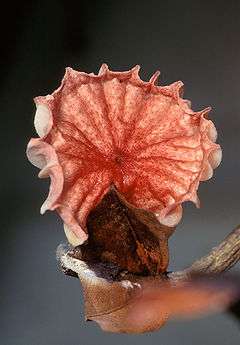Moniliophthora perniciosa
| Moniliophthora perniciosa | |
|---|---|
 | |
| Scientific classification | |
| Kingdom: | Fungi |
| Phylum: | Basidiomycota |
| Class: | Basidiomycetes |
| Subclass: | Agaricomycetidae |
| Order: | Agaricales |
| Family: | Marasmiaceae |
| Genus: | Moniliophthora |
| Species: | M. perniciosa |
| Binomial name | |
| Moniliophthora perniciosa (Stahel) Aime & Phillips-Mora, (2005) | |
| Synonyms | |
|
Crinipellis perniciosa (Stahel) Singer, (1943) | |
Moniliophthora perniciosa (previously Crinipellis perniciosa)[1] is a fungus that causes "Witches' Broom Disease" (WBD) of the cocoa tree (Theobroma cacao). This pathogen is currently limited to South America, Panama and the Caribbean, and is perhaps one of the best-known cocoa diseases, thought to have co-evolved with cocoa in its centre of origin (first recorded in the Brazilian Amazon in 1785). In 1989, it was introduced to the cocoa producing state of Bahia of Brazil, where output diminished from 380,000 tonnes per annum to 90,000 tonnes in the late 1990s. Brazil went from being the world’s second largest cocoa producer to becoming a net importer. Unlike frosty pod rot, which is highly infectious but mostly destructive to pods, WBD can infect many sites on actively growing trees, throughout the growing season, and in severe cases can cause tree death.
This fungus is hemibiotroph, with two characteristic phases: biotrophic (expanding and infecting, on living tissue) and saprotrophic (producing basidiospores, on necrotic tissue). The biotrophic stage, and what triggers its switch to a saprotrophic stage, are still not understood.
The spores of this fungus are spread by wind, but must land in water in order to germinate. As a consequence, it mainly spreads during rainy periods. Control is very difficult, and requires extensive work to remove. The most critical part of treatment (pruning of diseased material) can only be conducted during dry periods, or one risks spreading the disease further. Due to economics, most discarded brooms are usually left on the ground, leaving a risk of reinfection of trees the subsequent year. However, spraying the ground with a light coating of oil can prevent the spores from becoming airborne again.
References
- ↑ Aime, M.C.; Phillips-Mora, W. (2005). "The causal agents of witches' broom and frosty pod rot of cacao (chocolate, Theobroma cacao) form a new lineage of Marasmiaceae". Mycologia. 97: 1012–1022. doi:10.3852/mycologia.97.5.1012. PMID 16596953.
External links
- Index Fungorum
- USDA ARS Fungal Database
- Moniliophthora perniciosa genome sequencing at Laboratory of Genomics and Expression